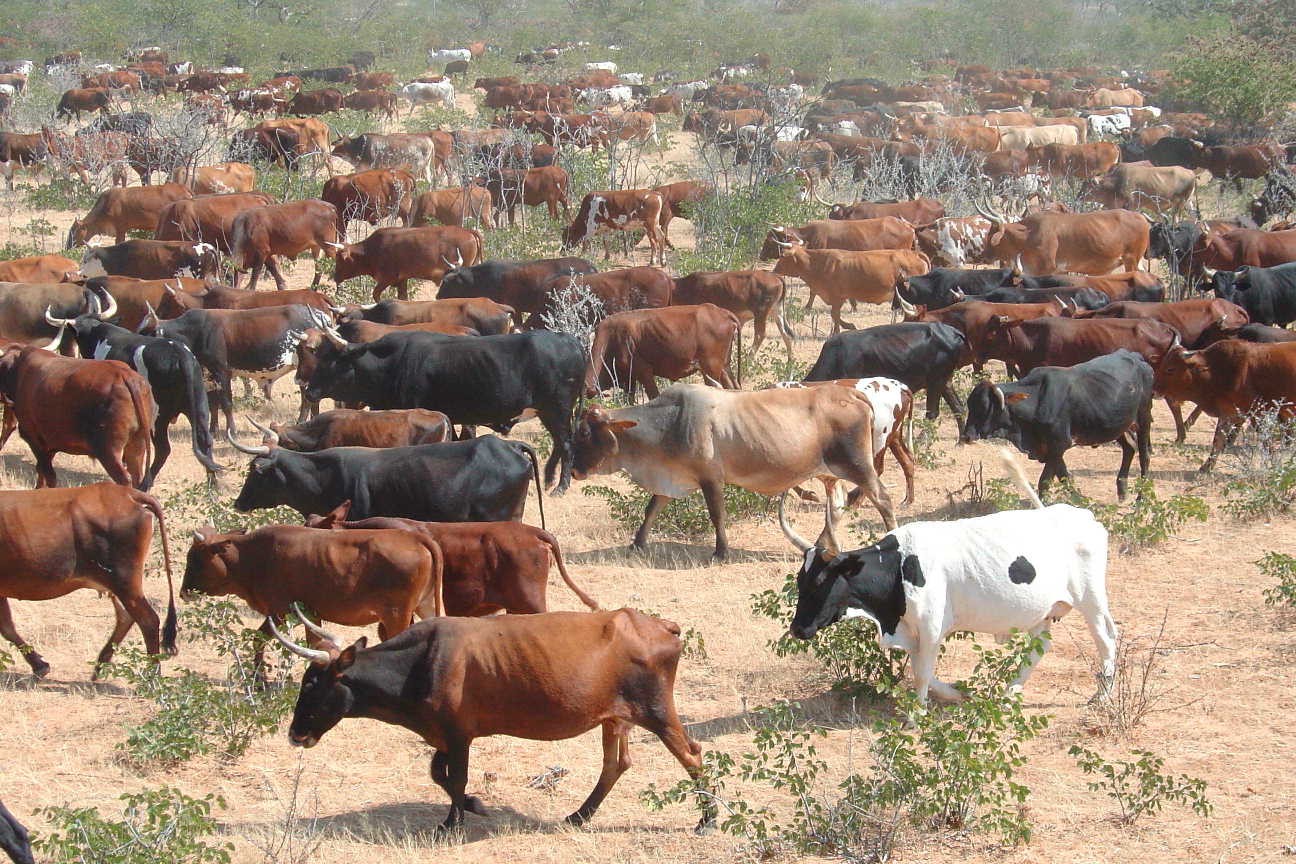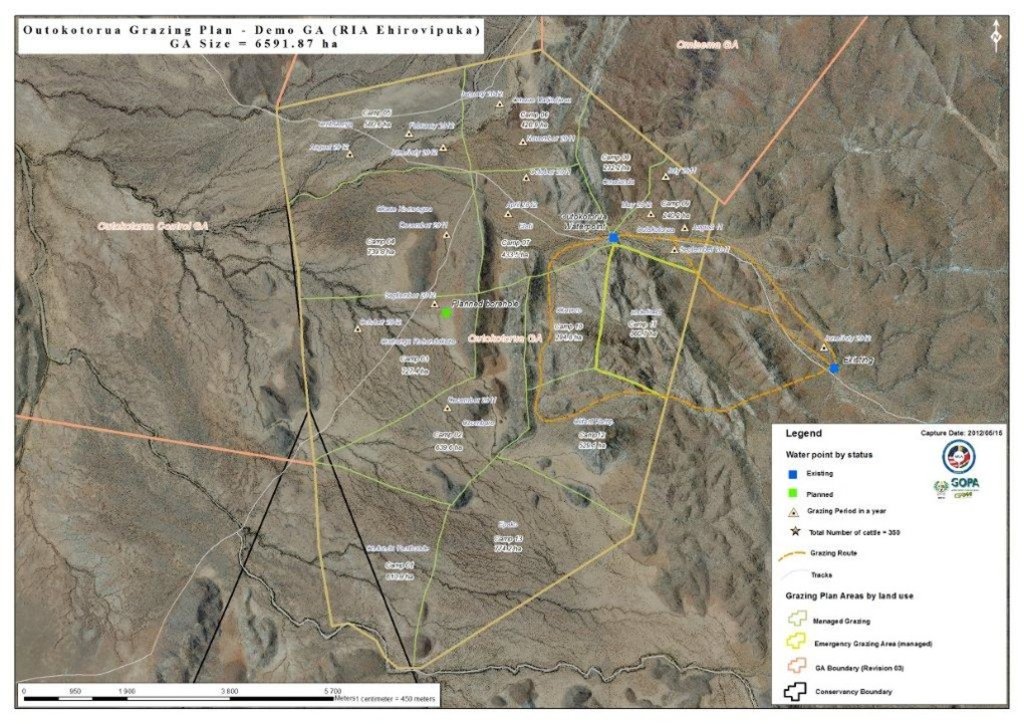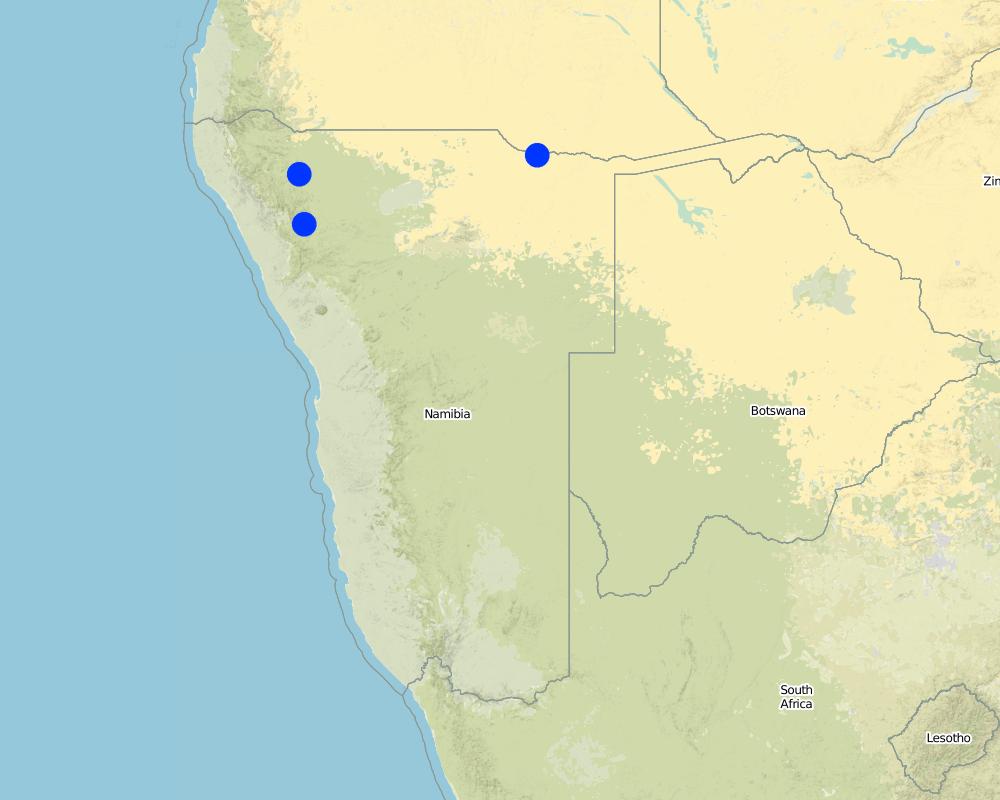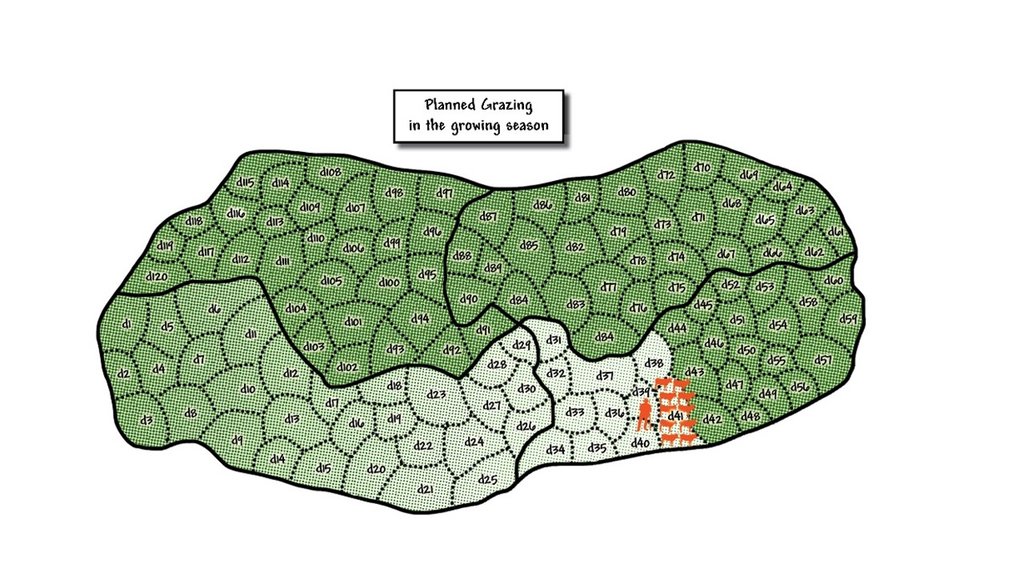Combined herding for planned grazing [Namíbia]
- Criação:
- Atualização:
- Compilador/a: Ibo Zimmermann
- Editor: –
- Revisor: Rima Mekdaschi Studer
Omarisiro wovinamuinjo motjimbumba
technologies_3326 - Namíbia
- Resumo completo em PDF
- Resumo completo em PDF para impressão
- Resumo completo no navegador
- Resumo completo (sem formatação)
- Combined herding for planned grazing: 11 de Julho de 2018 (inactive)
- Combined herding for planned grazing: 11 de Julho de 2018 (inactive)
- Combined herding for planned grazing: 31 de Maio de 2019 (inactive)
- Combined herding for planned grazing: 2 de Novembro de 2021 (public)
- Combined herding for planned grazing: 23 de Fevereiro de 2018 (inactive)
- Combined herding for planned grazing: 4 de Fevereiro de 2018 (inactive)
Veja as seções
Expandir tudo Recolher tudo1. Informação geral
1.2 Detalhes do contato das pessoas capacitadas e instituições envolvidas na avaliação e documentação da tecnologia
Especialista em GST:
Especialista em GST:
Nome do projeto que facilitou a documentação/avaliação da Tecnologia (se relevante)
Southern African Science Service Centre for climate change and Adaptive Land management (SASSCAL)Nome da(s) instituição(ões) que facilitou(ram) a documentação/ avaliação da Tecnologia (se relevante)
Namibia University of Science and Technology ( NUST) - NamíbiaNome da(s) instituição(ões) que facilitou(ram) a documentação/ avaliação da Tecnologia (se relevante)
Conservation Agriculture Namibia (Conservation Agriculture Namibia) - Namíbia1.3 Condições em relação ao uso da informação documentada através de WOCAT
Quando os dados foram compilados (no campo)?
20/06/2017
O/a compilador/a e a(s) pessoa(s) capacitada(s) aceitam as condições relativas ao uso de dados documentados através da WOCAT:
Sim
1.4 Declaração de sustentabilidade da tecnologia descrita
A tecnologia descrita aqui é problemática em relação a degradação da terra de forma que não pode ser declarada uma tecnologia de gestão sustentável de terra?
Não
1.5 Referência ao(s) questionário(s) sobre as abordagens da GST
2. Descrição da tecnologia de GST
2.1 Descrição curta da tecnologia
Definição da tecnologia:
Daily combination of livestock from all households into a single herd to drive to different designated portions of the communal grazing area so that grass may recover to replenish its food reserves before being regrazed some months later.
2.2 Descrição detalhada da tecnologia
Descrição:
The technology is currently being applied in communal as well as commercial farms of Namibia. It is particularly effective in areas with no fences and areas with high incidence of stock theft and predator losses. The technology aims to replace continuous grazing with planned grazing which allows recovery of grass plants in the growing season and prepares the soil and grass plants for the upcoming rainy season during the non growing season. In addition fixed carrying capacities are replaced by flexible stocking rates which track availability of forage. Two grazing plans are developed per year, one when perennial grasses are growing and one when they are dormant. The grazing plans may change depending on the season and unanticipated events such as fire. During the growing season a grazing plan is in place that ensures plants are not regrazed before they have recovered their root reserves and that animal performance is good. In the non growing season animal numbers are adjusted to ensure there is sufficient grass to last until rains are reliably expected. Several selections are planned for to ensure animal performance is good.
The grazing plans must take into account all factors that affect the livestock performance as well as the farmer. These factors include first rains, natural pans, animal performance, ensuring good quality forage for cows prior to bulling, poisonous plants, time for vaccinations, where the livestock should be when the farmer is on leave etc. Once the plan has been developed, the animals are herded using low stress handling techniques according to the plan to various parts of the farm or communal grazing area. Moving livestock by herding enables fire breaks to be created by deliberate overtrampling. Each night the livestock are brought back to a kraal where they are kept overnight. Watering of livestock can take place in the kraal at night or in the morning or in the field depending on water availability. This process is repeated day after day.
At the end of each growing season the amount of forage available to the current herd is estimated and animal numbers are adjusted to ‘ensure’ that rains will have been received whilst there is still sufficient forage for the livestock and leaving enough soil cover to feed the soil organisms and protect the soil. Deciding when the forager grown in the last growing season will run out must be done using a method that farmers relate to. Farmers may decide to meet and reach consensus on this based on their knowledge of the effectiveness of rainfall during this season and past experience. If it is decided that there is sufficient food to see the animals through until the next rains can be expected, then farmers have enough forage and may even be able to re-stock if there is a food excess. If however a forage shortage is expected, because too little grass was grown in the last growing season to see them through to the next rains, then de-stocking is needed. The severity of the forage shortage determines how many livestock can be carried on this land during this non-growing season. Again farmers can reach consensus on this. Deciding whose animals to sell and how many is always a thorny issue so farmers will always move excessive animals to other areas if possible or sell unproductive animals first if needed.
2.3 Fotos da tecnologia
2.4 Vídeos da tecnologia
Comentários, breve descrição:
Combined herding to manage communal grazing
www.youtube.com/watch?v=xNyFkDUH6MQ
Data:
2007
Localização:
Erora
Nome do cinegrafista:
Andrew Botelle
Comentários, breve descrição:
Stress-free herding
www.youtube.com/watch?v=3Ey5v40KtkI
Data:
2007
Localização:
Erora
Nome do cinegrafista:
Andrew Botelle
Comentários, breve descrição:
Managing water flow to repair gully erosion
www.youtube.com/watch?v=6C4V_Cib8ts
Data:
23/04/2015
Localização:
Erora
Nome do cinegrafista:
Andrew Botelle
2.5 País/região/locais onde a tecnologia foi aplicada e que estão cobertos nesta avaliação
País:
Namíbia
Região/Estado/Província:
Kunene Region
Especificação adicional de localização:
Communal grazing areas of Erora, Outokotorua and Nsindi
Map
×2.6 Data da implementação
Indique o ano de implementação:
2004
2.7 Introdução da tecnologia
Especifique como a tecnologia foi introduzida:
- através de projetos/intervenções externas
Comentários (tipos de projeto, etc.):
Community projects facilitated by NGO "Conservation Agriculture Namibia"
3. Classificação da tecnologia de GST
3.1 Principal/principais finalidade(s) da tecnologia
- Melhora a produção
- Reduz, previne, recupera a degradação do solo
- Preserva ecossistema
- Protege uma bacia/zonas a jusante – em combinação com outra tecnologia
- Preservar/melhorar a biodiversidade
- Reduzir riscos de desastre
- Adaptar a mudanças climáticas/extremos e seus impactos
- Atenuar a mudanças climáticas e seus impactos
- Criar impacto econômico benéfico
- Cria impacto social benéfico
- Reduce human-wildlife conflict
3.2 Tipo(s) atualizado(s) de uso da terra onde a tecnologia foi aplicada

Pastagem
Pastagem extensiva:
- Seminomadismo/pastoralismo
Principais espécies animais e produtos:
Livestock, increased forage production, improved animal performance
3.3 Mais informações sobre o uso da terra
Abastecimento de água para a terra na qual a tecnologia é aplicada:
- Precipitação natural
Número de estações de cultivo por ano:
- 1
Densidade animal (se relevante):
Livestock density is high as a result of herding, but stocking rate varies
3.4 Grupo de GST ao qual pertence a tecnologia
- Gestão de pastoralismo e pastagem
3.5 Difusão da tecnologia
Especifique a difusão da tecnologia:
- Uniformemente difundida numa área
Caso a tecnologia seja uniformemente difundida numa área, indique a área coberta aproximada:
- 100-1.000 km2
Comentários:
Animals are herded over the entire area – except areas that are too steep for livestock to walk up.
3.6 Medidas de GST contendo a tecnologia

Medidas de gestão
- M4: Principal mudança no calendário de atividades
Comentários:
The technology does not involve a change in land use. The grazing plan means that livestock will only be on a particular piece of land twice in any given year (once in the growing season and once in the non growing season). The animal density is however high, leading to increased impact for a very short period.
3.7 Principais tipos de degradação da terra abordados pela tecnologia

Erosão do solo pela água
- Wt: Perda do solo superficial/erosão de superfície
- Wg: Erosão por ravinas/ravinamento
- Wo: efeitos de degradação externa

Erosão do solo pelo vento
- Et: Perda do solo superficial

Deteriorização física do solo
- Pk: quebra e ressecamento

Degradação biológica
- Bc: redução da cobertura vegetal
- Bq: quantidade/ declínio da biomassa
- Bs: Qualidade e composição de espécies/declínio de diversidade
- Bl: perda da vida do solo

Degradação da água
- Ha: aridificação
- Hs: mudança na quantidade de água de superfície
- Hg: mudança no lençol freático/aquífero
Comentários:
The control of over-trampling which otherwise leads to rill and gulley erosion
3.8 Redução, prevenção ou recuperação da degradação do solo
Especifique o objetivo da tecnologia em relação a degradação da terra:
- Recuperar/reabilitar solo severamente degradado
Comentários:
Land is severely degraded but can be restored by change in management
4. Especificações técnicas, implementação de atividades, entradas e custos
4.1 Desenho técnico da tecnologia
4.2 Especificações técnicas/ explicações do desenho técnico
Schematic diagram of planned grazing of a growing season grazing plan. In this diagram grazing started in the bottom left hand camp, marked d1, and the livestock were grazed in this area for this day. The next day the herd of livestock were taken to the area marked d2 and grazed there. This continued until day 41 where the livestock are currently. If deviations from plan occur then the actual grazing map is marked according to what actually happened. This is the map that helps inform next year's grazing plan to avoid using certain camps at the same time of year. The degree of greenness in the diagram indicates the amount of recovery of grass since being grazed. It is lightest in the area just grazed, marked d40. By the time the herd reaches day 120, which has the darkest green indicating readiness to be re-grazed, then the grass in the area marked d1 was planned to have recovered sufficiently to be regrazed. This plan has a built in recovery period of 120 days. It is possible that growth rates are slower than expected and it may be necessary to reduce numbers of cattle in the herd to slow down the movement to ensure the desired recovery period is achieved.
4.3 Informação geral em relação ao cálculo de entradas e custos
Especifique como custos e entradas foram calculados:
- por área de tecnologia
Indique o tamanho e a unidade de área:
5000 ha
Especifique a moeda utilizada para os cálculos de custo:
- Dólares norte-americanos
Indique a média salarial da mão-de-obra contratada por dia:
USD 4
4.4 Atividades de implantação
| Atividade | Tipo de medida | Periodicidade | |
|---|---|---|---|
| 1. | Three meetings for mobilisation of communities | Gestão | Month 1 |
| 2. | Exchange visit to local farmers using this practise | Gestão | Month 4 |
| 3. | Assess water infrastructure, site and drill and install additional water point | Estrutural | Month 6 |
| 4. | Grazing planning meeting with stakeholders | Gestão | After adequate grass growth to enable planned grazing |
| 5. | Appoint, equip and train herders | Gestão | After 4 |
| 6. | Planning meeting and determination of starting date | Gestão | After 5 |
| 7. | Build overnight kraals at new water points | Estrutural | When needed |
| 8. | Build temporary kraals for improved grass growth | Estrutural | When needed |
4.5 Custos e entradas necessárias para a implantação
| Especifique a entrada | Unidade | Quantidade | Custos por unidade | Custos totais por entrada | % dos custos arcados pelos usuários da terra | |
|---|---|---|---|---|---|---|
| Mão-de-obra | Six herders (four on duty per day) for 400 cattle | Months | 6,0 | 77,0 | 462,0 | 100,0 |
| Mão-de-obra | One manager | Month | 1,0 | 115,0 | 115,0 | 100,0 |
| Equipamento | Overalls, boots and hat that may need replacement after one year | Set | 7,0 | 100,0 | 700,0 | 100,0 |
| Material de construção | Housing for herders built from mud and dung | Shelter | 3,0 | 100,0 | 300,0 | 100,0 |
| Outros | Laminated grazing chart and map per year | Document | 2,0 | 10,0 | 20,0 | |
| Custos totais para a implantação da tecnologia | 1597,0 | |||||
Se o usuário da terra arca com menos que 100% dos custos, indique quem cobre os custos remanescentes:
Grazing maps and charts prodcuded by CAN (support NGO), but will be taken over soon by farmers
4.6 Atividades recorrentes/manutenção
| Atividade | Tipo de medida | Periodicidade/frequência | |
|---|---|---|---|
| 1. | Daily herding, watering of livestock and health checks and treatment | Gestão | Daily |
| 2. | Maintenance of kraals and water points | Estrutural | Quartery |
4.7 Custos e entradas necessárias pata a manutenção/atividades recorrentes (por ano)
| Especifique a entrada | Unidade | Quantidade | Custos por unidade | Custos totais por entrada | % dos custos arcados pelos usuários da terra | |
|---|---|---|---|---|---|---|
| Mão-de-obra | Six herders (four on duty per day) for 400 cattle | Months | 6,0 | 77,0 | 462,0 | 100,0 |
| Mão-de-obra | One manager | Month | 1,0 | 115,0 | 115,0 | 100,0 |
| Equipamento | Overalls, boots and hat, replaced annually | Set | 7,0 | 100,0 | 700,0 | 100,0 |
| Material de construção | Maintenance of clay and dung housing for herders | Shelters | 3,0 | 100,0 | 300,0 | 100,0 |
| Outros | Diesel for pumping water per month | Litres | 100,0 | 1,0 | 100,0 | 100,0 |
| Outros | Laminated grazing chart and map per year | Documents | 2,0 | 10,0 | 20,0 | 100,0 |
| Custos totais para a manutenção da tecnologia | 1697,0 | |||||
4.8 Fatores mais importantes que afetam os custos
Descreva os fatores mais determinantes que afetam os custos:
Appreciation by land users that investment in herders will pay back, especially from the second year onwards.
5. Ambiente natural e humano
5.1 Clima
Precipitação pluviométrica anual
- <250 mm
- 251-500 mm
- 501-750 mm
- 751-1.000 mm
- 1.001-1.500 mm
- 1.501-2.000 mm
- 2.001-3.000 mm
- 3.001-4.000 mm
- > 4.000 mm
Especificações/comentários sobre a pluviosidade:
Summer rainfall December-March
Indique o nome da estação meteorológica de referência considerada:
Opuwo
Zona agroclimática
- Árido
5.2 Topografia
Declividade média:
- Plano (0-2%)
- Suave ondulado (3-5%)
- Ondulado (6-10%)
- Moderadamente ondulado (11-15%)
- Forte ondulado (16-30%)
- Montanhoso (31-60%)
- Escarpado (>60%)
Formas de relevo:
- Planalto/planície
- Cumes
- Encosta de serra
- Encosta de morro
- Sopés
- Fundos de vale
Zona de altitude:
- 0-100 m s.n.m.
- 101-500 m s.n.m.
- 501-1.000 m s.n.m.
- 1.001-1.500 m s.n.m.
- 1.501-2.000 m s.n.m.
- 2.001-2.500 m s.n.m.
- 2.501-3.000 m s.n.m.
- 3.001-4.000 m s.n.m.
- > 4.000 m s.n.m.
Indique se a tecnologia é aplicada especificamente em:
- Não relevante
5.3 Solos
Profundidade do solo em média:
- Muito raso (0-20 cm)
- Raso (21-50 cm)
- Moderadamente profundo (51-80 cm)
- Profundo (81-120 cm)
- Muito profundo (>120 cm)
Textura do solo (solo superficial):
- Grosso/fino (arenoso)
Textura do solo (>20 cm abaixo da superfície):
- Médio (limoso, siltoso)
Matéria orgânica do solo superficial:
- Baixo (<1%)
5.4 Disponibilidade e qualidade de água
Lençol freático:
> 50 m
Disponibilidade de água de superfície:
Médio
Qualidade da água (não tratada):
Água potável boa
A salinidade da água é um problema?
Não
Ocorre inundação da área?
Sim
Regularidade:
Esporadicamente
5.5 Biodiversidade
Diversidade de espécies:
- Médio
Diversidade de habitat:
- Médio
5.6 Características dos usuários da terra que utilizam a tecnologia
Sedentário ou nômade:
- Sedentário
- Semi-nômade
Orientação de mercado do sistema de produção:
- Misto (subsistência/comercial)
Rendimento não agrícola:
- 10-50% de toda renda
Nível relativo de riqueza:
- Média
Indivíduos ou grupos:
- Grupos/comunidade
Nível de mecanização:
- Trabalho manual
Gênero:
- Mulheres
- Homens
Idade dos usuários da terra:
- meia-idade
Indique outras características relevantes dos usuários da terra:
In dry years all livestock may move to another cattle post. But they return to the sedentary site as their main grazing area. A significant number of land users take up employment in the nearest town.
5.7 Média da área de terra própria ou arrendada por usuários da terra que utilizam a tecnologia
- < 0,5 ha
- 0,5-1 ha
- 1-2 ha
- 2-5 ha
- 5-15 ha
- 15-50 ha
- 50-100 ha
- 100-500 ha
- 500-1.000 ha
- 1.000-10.000 ha
- > 10.000 ha
É considerado pequena, média ou grande escala (referente ao contexto local)?
- Média escala
Comentários:
Communal land is not owned or leased, but the community has rights to use it for agricultural purposes
5.8 Propriedade de terra, direitos de uso da terra e de uso da água
Propriedade da terra:
- Estado
Direitos do uso da terra:
- Comunitário (organizado)
Direitos do uso da água:
- Comunitário (organizado)
Comentários:
Land is communal and organised but no rights to enforce management are yet in place through formal structures.
5.9 Acesso a serviços e infraestrutura
Saúde:
- Pobre
- Moderado
- Bom
Educação:
- Pobre
- Moderado
- Bom
Assistência técnica:
- Pobre
- Moderado
- Bom
Emprego (p. ex. não agrícola):
- Pobre
- Moderado
- Bom
Mercados:
- Pobre
- Moderado
- Bom
Energia:
- Pobre
- Moderado
- Bom
Vias e transporte:
- Pobre
- Moderado
- Bom
Água potável e saneamento:
- Pobre
- Moderado
- Bom
Serviços financeiros:
- Pobre
- Moderado
- Bom
6. Impactos e declarações finais
6.1 Impactos no local mostrados pela tecnologia
Impactos socioeconômicos
Produção
Produção de forragens
Produção animal
Risco de falha de produção
Gestão de terra
Comentários/especificar:
Improved, not simplified
Disponibilidade e qualidade de água
Disponibilidade de água para criação de animais
Renda e custos
Despesas com insumos agrícolas
Rendimento agrícola
Disparidades econômicas
Carga de trabalho
Impactos socioculturais
Segurança alimentar/auto-suficiência
Direitos do uso da terra/à água
Instituições comunitárias
Conhecimento de GST/ degradação da terra
Atenuação de conflitos
Impactos ecológicos
Ciclo hídrico/escoamento
Escoamento superficial
Evaporação
Solo
Umidade do solo
Cobertura do solo
Perda de solo
Ressecamento/ selagem do solo
Ciclo e recarga de nutrientes
Biodiversidade: vegetação, animais
Cobertura vegetal
Diversidade vegetal
Diversidade animal
Clima e redução de riscos de desastre
Impactos da seca
Risco de incêndio
Microclima
6.2 Impactos externos mostrados pela tecnologia
Community's cattle no longer graze on land of neighbouring communities
6.3 Exposição e sensibilidade da tecnologia às mudanças climáticas graduais e extremos/desastres relacionados ao clima (conforme o ponto de vista dos usuários da terra)
Mudança climática gradual
Mudança climática gradual
| Estação do ano | Tipo de mudança climática/extremo | Como a tecnologia lida com isso? | |
|---|---|---|---|
| Temperatura anual | aumento | moderadamente | |
| Precipitação pluviométrica anual | redução/diminuição | moderadamente |
Extremos (desastres) relacionados ao clima
Desastres meteorológicos
| Como a tecnologia lida com isso? | |
|---|---|
| Trovoada local | bem |
Desastres climatológicos
| Como a tecnologia lida com isso? | |
|---|---|
| Seca | moderadamente |
| Queimada | bem |
6.4 Análise do custo-benefício
Como os benefícios se comparam aos custos de implantação (do ponto de vista dos usuários da terra)?
Retornos a curto prazo:
positivo
Retornos a longo prazo:
muito positivo
Como os benefícios se comparam aos custos recorrentes/de manutenção(do ponto de vista dos usuários da terra)?
Retornos a curto prazo:
muito positivo
Retornos a longo prazo:
muito positivo
Comentários:
The ability to bring back perennial grasses results in higher stocking rates, less drought risk and better quality animals, therefore higher income over time and therefore a good cost benefit analysis.
6.5 Adoção da tecnologia
- 1-10%
Se disponível, determine a quantidade (número de unidades familiares e/ou área abordada):
20,000 ha
Entre todos aqueles que adotaram a tecnologia, quantos adotaram espontaneamente, ou seja, sem receber nenhum incentivo material/pagamentos?
- 0-10%
Comentários:
This is a key issue undergoing lobbying of government and the communal farmers union to establish through a consultative process legislation that enables grazing plans to be enforced from within and from outside. This is lacking at the moment.
6.6 Adaptação
A tecnologia foi recentemente modificada para adaptar-se as condições variáveis?
Sim
Outros (especificar):
Adaptive management
Especifique a adaptação da tecnologia (desenho, material/espécie, etc):
Addition of erosion control and overnight kraaling to assist with gully control. Refining re-planning in response to monitored results that show deviation from aims.
6.7 Pontos fortes/vantagens/oportunidades da tecnologia
| Pontos fortes/vantagens/oportunidades na visão do usuário da terra |
|---|
| It is cost effective, real improvement is seen in grass production while livestock losses to predators are significantly reduced. |
| For absentee owners they can leave a manager and herders in place to get on with the work and this can be easily evaluated after time since animals wondering around leave evidence. |
| Livestock are better cared for as they used to be and a sense of community has been restored. |
| Pontos fortes/vantagens/oportunidades na visão do/a compilador/a ou de outra pessoa capacitada |
|---|
| This is a viable and upscaleable technology for both communal and commercial farmland in Namibia and beyond. |
| It addresses the root cause of livestock related degradation and at a global scale can have a significant impact on mitigating climate change if all the degraded rangelands of the dry climates of the world are restored by using the principles embodied in this approach – which has been adopted in the National Rangeland Management Policy and Strategy. Moreover it can improve the quality of lives of millions of people who live in areas where livestock is the only viable land use. |
| This is a true triple bottom line technology that improves the resource base whilst increasing profits and enbables an improved quality of life of residents. |
6.8 Pontos fracos, desvantagens/riscos da tecnologia e formas de superá-los
| Pontos fracos/desvantagens/riscos na visão do usuário da terra | Como eles podem ser superados? |
|---|---|
| Herders are difficult to find, train and keep. | National level vocational training of herders is required. |
| Water infrastructure tends to result in overtrampling of the same routes. | The Directorate of Rural Water Supply should change its water specifications to include the provision of water for livestock – which can be cheap and effective. |
| Grass poaching takes place by neighbours and the majority will of people in an area is sometimes overrun by a small minority. | Farmers Unions must address these issues and get enforceable mechanisms in place for improved rangeland management. |
| Pontos fracos/vantagens/riscos na visão do/a compilador/a ou de outra pessoa capacitada | Como eles podem ser superados? |
|---|---|
| There is insufficient national buy-in from line ministries in terms of implementation to address many of the issues that have been raised. | Line ministries should support implementation to address these problems. Joint implementation, joint review and adaptation by government, unions, farmers and support providers will assist in solving many issues for resource base improvement. |
7. Referências e links
7.1 Métodos/fontes de informação
- entrevistas com especialistas em GST
7.2 Referências às publicações disponíveis
Título, autor, ano, ISBN:
Holistic mangement, Savory, A. & Butterfield, J., 1991
Disponível de onde? Custos?
Island Press
7.3 Links para informação relevante que está disponível online
Título/ descrição:
Volkmann, W. (2011). Community based rangeland and livestock management. Windhoek: GOPA-CBRLM.
URL:
https://rmportal.net/groups/cbrlm/cbrlm-for-review/namibia-community-based-rangeland-livestock-management-cbrlm-2nd-edition/view
Links e módulos
Expandir tudo Recolher tudoLinks
Não há links
Módulos
Não há módulos







